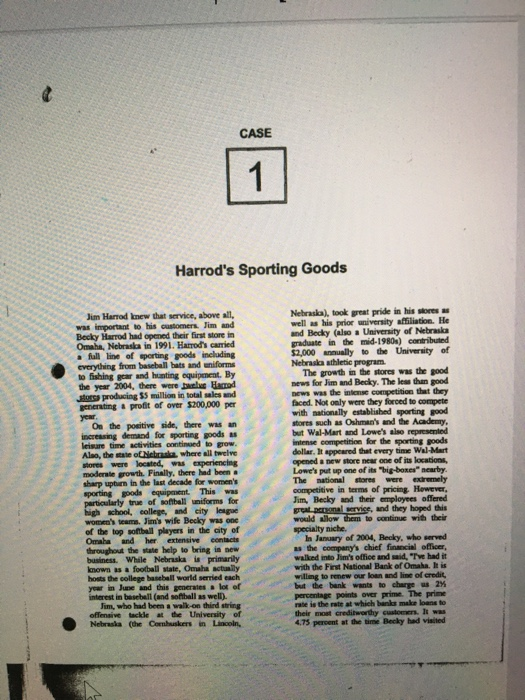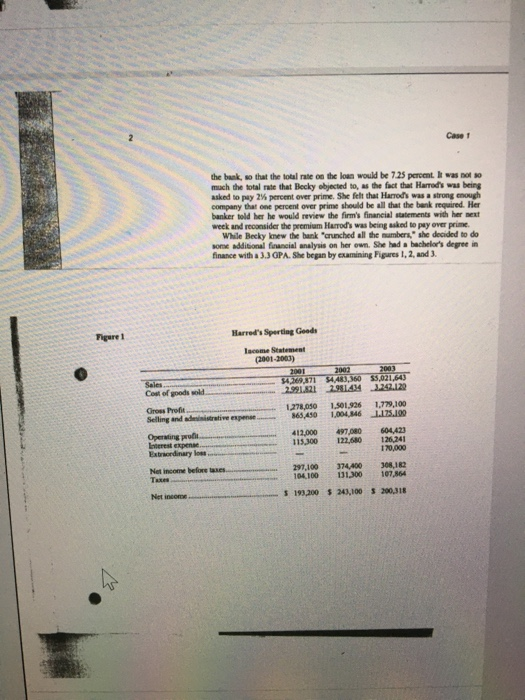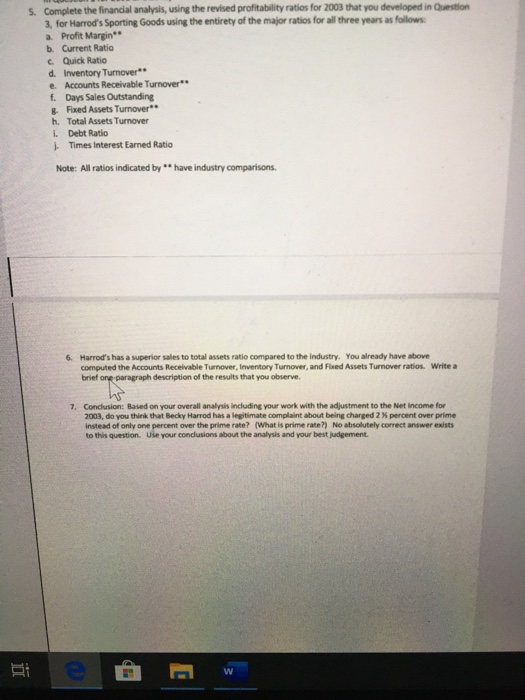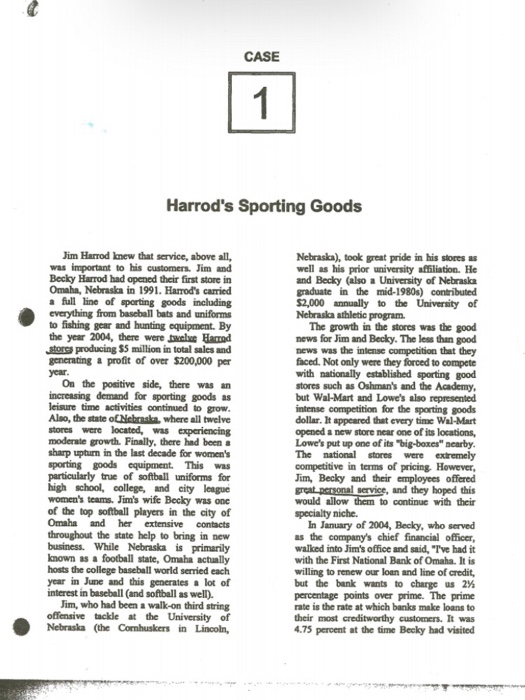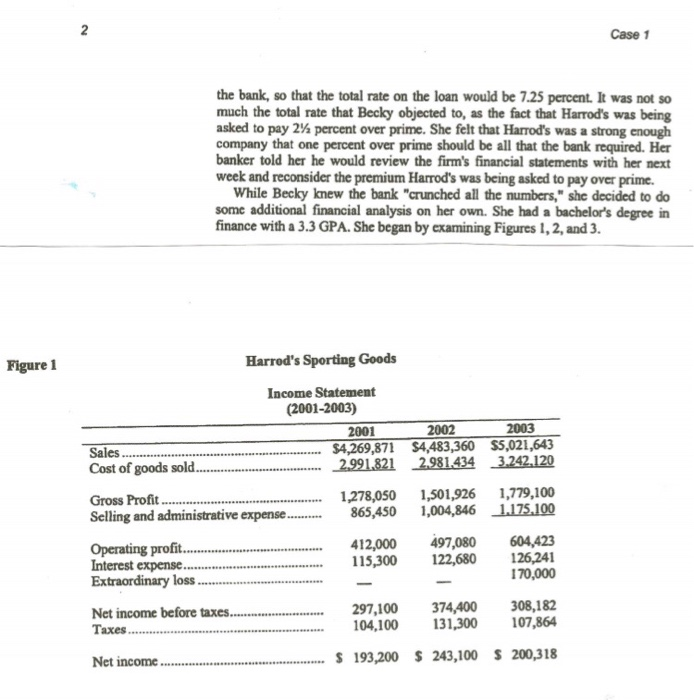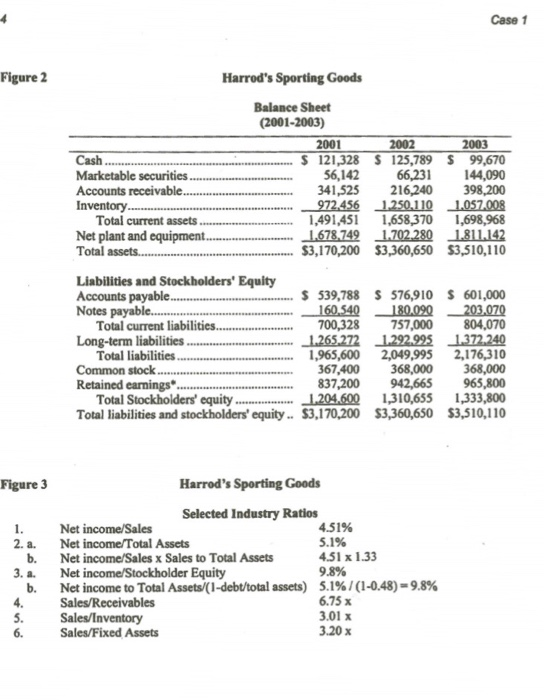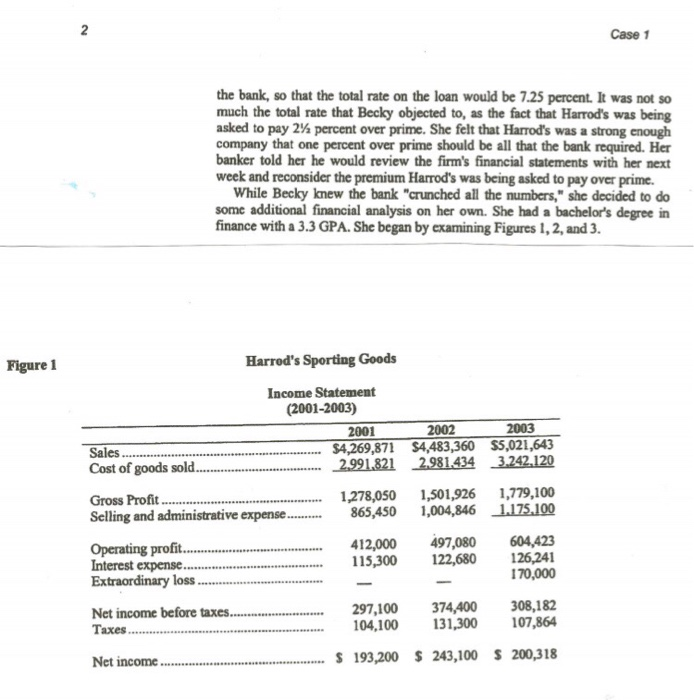Please solve problems 5-7.
CASE 1 Harrod's Sporting Goods Jim Harrod knew that service, above all, was important to his customers. Jim and Becky Harrod had opened their first store in Omaha, Nebraska in 1991. Harrod's carried full line of sporting goods including everything from baseball hats and uniforms to fishing gear and hunting equipment. By the year 2004, there were Herred ora producing $5 million in total sales and generating a profit of over $200,000 per On the positive side, there was an increasing demand for sporting poods lesare time activities continued to grow. Also, the state of Nebras, where all twelve stores were located was experiencing moderate growth. Finally, there had been sharp upturn in the last decade for women's sporting goods equipment. This was particularly true of softball uniforms for high school. college and city league women's team. Jim's wife Becky was one of the top softball players in the city of Omaha and her extensive contacts throughout the wate help to bring in new business. While Nebraska primarily nown as a football state, Omaha actually hoss the college baseball world seried each year in June and this generates a lot of interest in baseball (and softball as well). Jim, who had been a walk on third string offensive tackle at the University of Nebraska (the Corbuskers in Lincoln Nebraska), took great pride in his stores well as his prior university affiliation. He and Becky (also a University of Nebraska graduate in the mid-1980s) contributed $2,000 annually to the University of Nebraska athletic program The growth in the stores was the good news for Jim and Becky. The lewe than good news was the intense competition that they faced. Not only were they forced to compete with nationally established sporting good stores such as Oshman's and the Academy, but Wal-Mart and Lowe's also represented intense competition for the sporting goods dollar. It appeared that every time Wal-Mart opened a new store near one of its locations, Lowe's put up one of its "big-bores nearby The national stores were extremely competitive in terms of pricing. However, Jim, Becky and their employees offered preal penal service, and they hoped this would wlow them to continue with their specialty niche In January of 2004, Recky, who served as the company's chief financial officer, walked into m's office and said, "The had it with the Fest National Bank of Omaha. It is willing to renew our loan and line of credit, but the bank wants to charge u 2% percentage points over prime. The prime rate is the rate at which banks make loans to their most creditworthy customers. It was 4.75 percent at the time Becky had visited 2 Case 1 the bank, so that the total rate on the loan would be 7.25 percent. I was not so much the total rate that Becky objected to as the fact that Harrod's was being asked to pay 2% percent over prime. She felt that Harrods was a strong enough company that one percent over prime should be all that the bank required. Her banker told her he would review the firm's financial statements with her next week and reconsider the premium Harrod's was being asked to pay over prime While Becky knew the bank "crunched all the numbers, she decided to do some additional financial analysis on her own. She had a bachelor's degree in finance with a 3.JOPA. She began by examining Figures 1, 2 and 3. Figure 1 Harred's Sporting Goods Income Statement (2001-2003) 2002 2003 Sales S49871 SAJ,160 55,021,64) Cost of goods sold 2.991.12 2.931.434 2.242.120 Gross Profit 1278,050 1.501.926 1,779,100 Selling and distrative expense 863,450 1,004,846 1.175.100 Operating profil 412.000 497,080 604,423 Interest Expense 115,300 122.680 126,241 Extraordinary los 170,000 Net income before taxes 297.100 374,400 308,182 TARE 104.100 131.300 107.864 Net income $ 193,200 $ 243,100 $ 200,318 Case 1 Figure? Harred's Sporting Goods Balance Sheet (2001-2003) 2001 2002 2003 Cash $ 121,328 S 125,789 $ 99,670 Marketable securities 56,142 66,231 144,090 Accounts receivable 341,525 216,240 398,200 Inventory _972.45 1.250.110 1.057.000 Total current assets 1.491,451 1.658,370 1,698.968 Net plant and equipment 1.678.749 1.702.280 281L.142 Total assets 53,170,200 33,360,650 $3,510,110 Liabilities and Stockholders' Equity Accounts payable 5 539,788 5 576,910 S 601,000 Notes payable 160.549 180.092 203.070 Total current liabilities 700328 757,000 804,070 Long-term liabilities 1.265-272 L.292.003 1.372.240 Total liabilities 1,965,600 2,049,995 2,176,310 Common stock 367,400 360,000 368,000 Retained earnings 837,200 942,665 965,800 Total Stockholders' equity 1.204,500 1,310,655 1,333,800 Total liabilities and stockholders' equity .. $3,170,200 $3,360,650 $3,310,110 Figure 3 2. b. Harrods Sporting Goods Selected Industry Ratio Net Income Sales 4.31% Net Income Total Assets 5.1% Net Income Sales x Sales to Total Assets 4.51 x 133 Net Income Stockholder Equity 9.8% Net Income to Total Assets/l-debtotalets) 5.1%/(1-0.48) - 9.8% Sales Receivables 6.75 Sales/Inventory 3.01 Sales Fixed Asset 3. b. 4 S. 3.20 6 5. Complete the financial analysis, using the revised profitability ratios for 2003 that you developed in Question 3. for Harrod's Sporting Goods using the entirety of the major ratios for all three years as follows: a. Profit Margin b. Current Ratio c. Quick Ratio d. Inventory Turnover** e Accounts Receivable Turnover** f. Days Sales Outstanding & Fixed Assets Turnover ** h. Total Assets Turnover i Debt Ratio Times Interest Earned Ratio Note: All ratios indicated by ** have industry comparisons 6. Harrod's has a superior sales to total assets ratio compared to the industry. You already have above computed the Accounts Receivable Turnover, Inventory Turnover, and Faed Assets Turnover ratios. Write a brief one paragraph description of the results that you observe 7. Conclusion: Based on your overall analysis including your work with the adjustment to the Net Income for 2003, do you think that Becky Harrod has a legitimate complaint about being charged 2x percent over prime Instead of only one percent over the prime rate? (What is prime rate?) No absolutely correct answer exists to this question. Use your conclusions about the analysis and your best judgement e CASE 1 Harrod's Sporting Goods Jim Harrod knew that service, above all, was important to his customers. Jim and Becky Harrod had opened their first store in Omaha, Nebraska in 1991. Harrod's carried full line of sporting goods including everything from baseball bats and uniforms to fishing gear and hunting equipment. By the year 2004, there were twelve Harrod stors producing $5 million in total sales and generating a profit of over $200,000 per year. On the positive side, there was an increasing demand for sporting goods as leisure time activities continued to grow. Also, the state of Nebraska, where all twelve stores were located, was experiencing moderate growth. Finally, there had been sharp upturn in the last decade for women's sporting goods equipment. This was particularly true of softball uniforms for high school, college, and city league women's teams. Jim's wife Becky was one of the top softball players in the city of Omaha and her extensive contacts throughout the state help to bring in new business. While Nebraska is primarily known as a football state, Omaha actually hosts the college baseball world seried each year in June and this generates a lot of interest in baseball (and softball as well). Jim, who had been a walk-on third string offensive tackle at the University of Nebraska (the Comhuskers in Lincoln, Nebraska), took great pride in his stores as well as his prior university affiliation. He and Becky (also a University of Nebraska graduate in the mid-1980s) contributed $2,000 annually to the University of Nebraska athletic program The growth in the stores was the good news for Jim and Becky. The less than good news was the intense competition that they faced. Not only were they forced to compete with nationally established sporting good stores such as Oshman's and the Academy, but Wal-Mart and Lowe's also represented intense competition for the sporting goods dollar. It appeared that every time Wal-Mart opened a new store near one of its locations, Lowe's put up one of its "big-boxes" nearby. The national stores were extremely competitive in terms of pricing. However, Jim, Becky and their employees offered great personal service, and they hoped this would allow them to continue with their specialty niche. In January of 2004, Becky, who served as the company's chief financial officer, walked into Jim's office and said, "Tve had it with the First National Bank of Omaha. It is willing to renew our loan and line of credit, but the bank wants to charge us 2% percentage points over prime. The prime rate is the rate at which banks make loans to their most creditworthy customers. It was 4.75 percent at the time Becky had visited N Case 1 the bank, so that the total rate on the loan would be 7.25 percent. It was not so much the total rate that Becky objected to, as the fact that Harrod's was being asked to pay 2% percent over prime. She felt that Harrod's was a strong enough company that one percent over prime should be all that the bank required. Her banker told her he would review the firm's financial statements with her next week and reconsider the premium Harrod's was being asked to pay over prime. While Becky knew the bank "crunched all the numbers," she decided to do some additional financial analysis on her own. She had a bachelor's degree in finance with a 3.3 GPA. She began by examining Figures 1, 2, and 3. Figure 1 Harrod's Sporting Goods Income Statement (2001-2003) 2001 2002 2003 Sales $4,269,871 S4,483,360 $5,021,643 Cost of goods sold. 2.991.821 2.981,434 3.242.120 Gross Profit....... 1,278,050 1,501,926 1,779,100 Selling and administrative expense ... 865,450 1,004,846 1.175.100 Operating profit. 412,000 497,080 604,423 Interest expense. 115,300 122,680 126,241 Extraordinary loss. 170,000 Net income before taxes... 297,100 374,400 308,182 Taxes.. 104,100 131,300 107,864 Net income $ 193,200 $ 243,100 $ 200,318 Case 1 Figure 2 Harrod's Sporting Goods Balance Sheet (2001-2003) 2001 2002 2003 Cash $ 121,328 $ 125,789 S 99,670 Marketable securities. 56,142 66,231 144,090 Accounts receivable. 341,525 216,240 398,200 Inventory...... 972.456 1.250.110 1.057.008 Total current assets 1,491,451 1,658,370 1,698,968 Net plant and equipment.. 1.678,749 1.702.280 1.811.142 Total assets..... $3,170,200 $3,360,650 $3,510,110 Liabilities and Stockholders' Equity Accounts payable........ $ 539,788 S 576,910 $ 601,000 Notes payable.... 160.540 180.090 203.070 Total current liabilities.. 700,328 757,000 804,070 Long-term liabilities 1.265,272 1.292.995 1.372.240 Total liabilities.. 1,965,600 2,049,995 2,176,310 Common stock. 367,400 368,000 368,000 Retained earnings.. 837,200 942,665 965,800 Total Stockholders' equity. 1.204.600 1,310,655 1,333,800 Total liabilities and stockholders' equity.. $3,170,200 $3,360,650 $3,510,110 Figure 3 Harrod's Sporting Goods Selected Industry Ratios 1. Net income/Sales 4.51% 2. a. Net income/Total Assets 5.1% b. Net income/Sales x Sales to Total Assets 4.51 x 1.33 3. a. Net income/Stockholder Equity 9.8% b. Net income to Total Assets/(1-debt/total assets) 5.1% /(1-0.48) = 9.8% 4. Sales/Receivables 6.75 x 5. Sales/Inventory 3.01 x Sales/Fixed Assets 3.20 x 6. N Case 1 the bank, so that the total rate on the loan would be 7.25 percent. It was not so much the total rate that Becky objected to, as the fact that Harrod's was being asked to pay 2% percent over prime. She felt that Harrod's was a strong enough company that one percent over prime should be all that the bank required. Her banker told her he would review the firm's financial statements with her next week and reconsider the premium Harrod's was being asked to pay over prime. While Becky knew the bank "crunched all the numbers," she decided to do some additional financial analysis on her own. She had a bachelor's degree in finance with a 3.3 GPA. She began by examining Figures 1, 2, and 3. Figure 1 Harrod's Sporting Goods Income Statement (2001-2003) 2001 2002 2003 Sales $4,269,871 $4,483,360 $5,021,643 Cost of goods sold. 2.991,821 2.981.434 3.242,120 Gross Profit...... 1,278,050 1,501,926 1,779,100 Selling and administrative expense... 865,450 1,004,846 1.175.100 Operating profit. 412,000 497,080 604,423 Interest expense. 115,300 122,680 126,241 Extraordinary loss. 170,000 Net income before taxes... 297,100 374,400 308,182 Taxes... 104,100 131,300 107,864 Net income $ 193,200 $ 243,100 $ 200,318 5. Complete the financial analysis, using the revised profitability ratios for 2003 that you developed in Question 3, for Harrod's Sporting Goods using the entirety of the major ratios for all three years as follows: a. Profit Margin b. Current Ratio c. Quick Ratio d. Inventory Turnover e. Accounts Receivable Turnover** f. Days Sales Outstanding g. Fixed Assets Turnover** h. Total Assets Turnover i. Debt Ratio J. Times Interest Earned Ratio Note: All ratios indicated by ** have industry comparisons. 6. Harrod's has a superior sales to total assets ratio compared to the industry. You already have above computed the Accounts Receivable Turnover, Inventory Turnover, and Fixed Assets Turnover ratios. Write a brief one-paragraph description of the results that you observe. 7. Conclusion: Based on your overall analysis including your work with the adjustment to the Net Income for 2003, do you think that Becky Harrod has a legitimate complaint about being charged 2 % percent over prime instead of only one percent over the prime rate? (What is prime rate?) No absolutely correct answer exists to this question. Use your conclusions about the analysis and your best judgement
